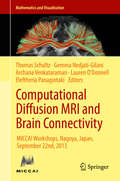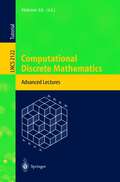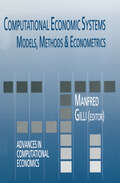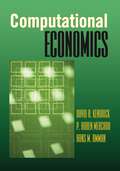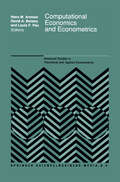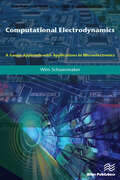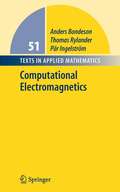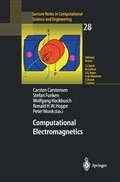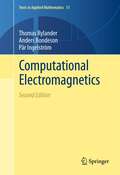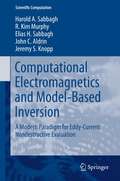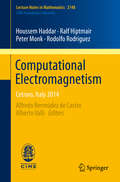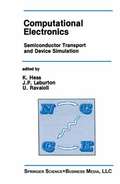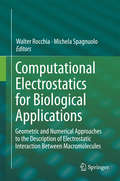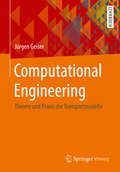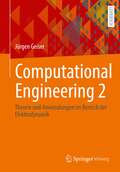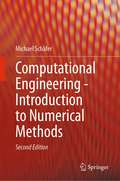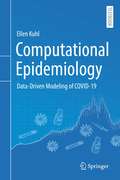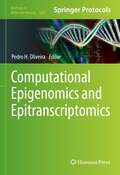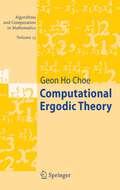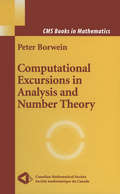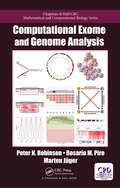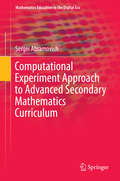- Table View
- List View
Computational Diffusion MRI and Brain Connectivity: MICCAI Workshops, Nagoya, Japan, September 22nd, 2013 (Mathematics and Visualization)
by Thomas Schultz Gemma Nedjati-Gilani Archana Venkataraman Lauren O'Donnell Eleftheria PanagiotakiThis volume contains the proceedings from two closely related workshops: Computational Diffusion MRI (CDMRI’13) and Mathematical Methods from Brain Connectivity (MMBC’13), held under the auspices of the 16th International Conference on Medical Image Computing and Computer Assisted Intervention, which took place in Nagoya, Japan, September 2013.Inside, readers will find contributions ranging from mathematical foundations and novel methods for the validation of inferring large-scale connectivity from neuroimaging data to the statistical analysis of the data, accelerated methods for data acquisition, and the most recent developments on mathematical diffusion modeling. This volume offers a valuable starting point for anyone interested in learning computational diffusion MRI and mathematical methods for brain connectivity as well as offers new perspectives and insights on current research challenges for those currently in the field. It will be of interest to researchers and practitioners in computer science, MR physics, and applied mathematics.
Computational Discrete Mathematics: Advanced Lectures (Lecture Notes in Computer Science #2122)
by Helmut AltThis book is based on a graduate education program on computational discrete mathematics run for several years in Berlin, Germany, as a joint effort of theoretical computer scientists and mathematicians in order to support doctoral students and advanced ongoing education in the field of discrete mathematics and algorithmics.The 12 selected lectures by leading researchers presented in this book provide recent research results and advanced topics in a coherent and consolidated way. Among the areas covered are combinatorics, graph theory, coding theory, discrete and computational geometry, optimization, and algorithmic aspects of algebra.
Computational Economic Systems: Models, Methods & Econometrics (Advances in Computational Economics #5)
by Manfred GilliThe approach to many problems in economic analysis has changed drastically with the development and dissemination of new and more efficient computational techniques. Computational Economic Systems: Models, Methods & Econometrics presents a selection of papers illustrating the use of new computational methods and computing techniques to solve economic problems. Part I of the volume consists of papers which focus on modelling economic systems, presenting computational methods to investigate the evolution of behavior of economic agents, techniques to solve complex inventory models on a parallel computer and an original approach for the construction and solution of multicriteria models involving logical conditions. Contributions to Part II concern new computational approaches to economic problems. We find an application of wavelets to outlier detection. New estimation algorithms are presented, one concerning seemingly related regression models, a second one on nonlinear rational expectation models and a third one dealing with switching GARCH estimation. Three contributions contain original approaches for the solution of nonlinear rational expectation models.
Computational Economics
by David A. Kendrick P. Ruben Mercado Hans M. AmmanThe ability to conceptualize an economic problem verbally, to formulate it as a mathematical model, and then represent the mathematics in software so that the model can be solved on a computer is a crucial skill for economists. Computational Economics contains well-known models--and some brand-new ones--designed to help students move from verbal to mathematical to computational representations in economic modeling. The authors' focus, however, is not just on solving the models, but also on developing the ability to modify them to reflect one's interest and point of view. The result is a book that enables students to be creative in developing models that are relevant to the economic problems of their times. Unlike other computational economics textbooks, this book is organized around economic topics, among them macroeconomics, microeconomics, and finance. The authors employ various software systems--including MATLAB, Mathematica, GAMS, the nonlinear programming solver in Excel, and the database systems in Access--to enable students to use the most advantageous system. The book progresses from relatively simple models to more complex ones, and includes appendices on the ins and outs of running each program. The book is intended for use by advanced undergraduates and professional economists and even, as a first exposure to computational economics, by graduate students. Organized by economic topics Progresses from simple to more complex models Includes instructions on numerous software systems Encourages customization and creativity
Computational Economics and Econometrics (Advanced Studies in Theoretical and Applied Econometrics #22)
by H. Amman D. A. Belsley L. F. PauThe field of Computational Economics is a fast growing area. Due to the limitations in analytical modeling, more and more researchers apply numerical methods as a means of problem solving. In tum these quantitative results can be used to make qualitative statements. This volume of the Advanced Series in Theoretical and Applied and Econometrics comprises a selected number of papers in the field of computational economics presented at the Annual Meeting of the Society Economic Dynamics and Control held in Minneapolis, June 1990. The volume covers ten papers dealing with computational issues in Econo metrics, Economics and Optimization. The first five papers in these proceedings are dedicated to numerical issues in econometric estimation. The following three papers are concerned with computational issues in model solving and optimization. The last two papers highlight some numerical techniques for solving micro models. We are sure that Computational Economics will become an important new trend in Economics in the coming decade. Hopefully this volume can be one of the first contributions highlighting this new trend. The Editors H.M. Amman et a1. (eds), Computational Economics and Econometrics, vii. © 1992 Kluwer Academic Publishers. PART ONE ECONOMETRICS LIKELIHOOD EVALUATION FOR DYNAMIC LATENT VARIABLES 1 MODELS DAVID F. HENDRY Nuffield College, Oxford, U.K. and JEAN-FRANc;mS RICHARD ISDS, Pittsburgh University, Pittsburgh, PA, U.S.A.
Computational Economics (PDF)
by David A. Kendrick P. Ruben Mercado Hans M. AmmanThe ability to conceptualize an economic problem verbally, to formulate it as a mathematical model, and then represent the mathematics in software so that the model can be solved on a computer is a crucial skill for economists. Computational Economics contains well-known models--and some brand-new ones--designed to help students move from verbal to mathematical to computational representations in economic modeling. The authors' focus, however, is not just on solving the models, but also on developing the ability to modify them to reflect one's interest and point of view. The result is a book that enables students to be creative in developing models that are relevant to the economic problems of their times. Unlike other computational economics textbooks, this book is organized around economic topics, among them macroeconomics, microeconomics, and finance. The authors employ various software systems--including MATLAB, Mathematica, GAMS, the nonlinear programming solver in Excel, and the database systems in Access--to enable students to use the most advantageous system. The book progresses from relatively simple models to more complex ones, and includes appendices on the ins and outs of running each program. The book is intended for use by advanced undergraduates and professional economists and even, as a first exposure to computational economics, by graduate students. Organized by economic topics Progresses from simple to more complex models Includes instructions on numerous software systems Encourages customization and creativity
Computational Electrodynamics: A Gauge Approach with Applications in Microelectronics
by Wim SchoenmakerComputational Electrodynamics is a vast research field with a wide variety of tools. In physics the principle of gauge invariance plays a pivotal role as a guide towards a sensible formulation of the laws of nature as well as computing the properties of elementary particles using the lattice formulation of gauge theories, yet the gauge principle has played a much less pronounced role in performing computation in classical electrodynamics. In this work the author will demonstrate that starting from the gauge formulation of electrodynamics using the electromagnetic potentials leads to computational tools that can very well compete with the conventional electromagnetic field-based tools. Once accepting the formulation based on gauge fields, the computational code is very transparent due to the mimetic mapping of the electrodynamic variables on the computational grid. Although the illustrations and applications originate from microelectronic engineering, the method has a much larger range of applicability. Therefore this book is of interest to everyone having interest in computational electrodynamics. The volume is organized as follows: In part 1, a detailed introduction and overview is presented of the Maxwell equations as well as the derivation of the current and charge densities is different materials. Semiconductors are responding to electromagnetic fields in a non-linear way and the induced complications are discussed in detail. In part 2, the transition of the theory of electrodynamics, using the gauge potentials, to a formulation that can serve as the gateway to computational code is presented. In part 3, the feasibility and success of the methods of part 2 are demonstrated by a collection of microelectronic device designs. Part 4 focuses on a set of topical themes that brings the reader to the frontier of research in building the simulation tools using the gauge principle in computational electrodynamics. Technical topics discussed in the book include:Electromagnetic Field EquationsConstitutive RelationsDiscretization and Numerical AnalysisFinite Element and Finite Volume MethodsDesign of Integrated Passive Components
Computational Electrodynamics: A Gauge Approach with Applications in Microelectronics
by Wim SchoenmakerComputational Electrodynamics is a vast research field with a wide variety of tools. In physics the principle of gauge invariance plays a pivotal role as a guide towards a sensible formulation of the laws of nature as well as computing the properties of elementary particles using the lattice formulation of gauge theories, yet the gauge principle has played a much less pronounced role in performing computation in classical electrodynamics. In this work the author will demonstrate that starting from the gauge formulation of electrodynamics using the electromagnetic potentials leads to computational tools that can very well compete with the conventional electromagnetic field-based tools. Once accepting the formulation based on gauge fields, the computational code is very transparent due to the mimetic mapping of the electrodynamic variables on the computational grid. Although the illustrations and applications originate from microelectronic engineering, the method has a much larger range of applicability. Therefore this book is of interest to everyone having interest in computational electrodynamics. The volume is organized as follows: In part 1, a detailed introduction and overview is presented of the Maxwell equations as well as the derivation of the current and charge densities is different materials. Semiconductors are responding to electromagnetic fields in a non-linear way and the induced complications are discussed in detail. In part 2, the transition of the theory of electrodynamics, using the gauge potentials, to a formulation that can serve as the gateway to computational code is presented. In part 3, the feasibility and success of the methods of part 2 are demonstrated by a collection of microelectronic device designs. Part 4 focuses on a set of topical themes that brings the reader to the frontier of research in building the simulation tools using the gauge principle in computational electrodynamics. Technical topics discussed in the book include:Electromagnetic Field EquationsConstitutive RelationsDiscretization and Numerical AnalysisFinite Element and Finite Volume MethodsDesign of Integrated Passive Components
Computational Electromagnetics (Texts in Applied Mathematics #51)
by Anders Bondeson Thomas Rylander Pär IngelströmDescribes most popular computational methods used to solve problems in electromagnetics Matlab code is included throughout, so that the reader can implement the various techniques discussed Exercises included
Computational Electromagnetics: Proceedings of the GAMM Workshop on Computational Electromagnetics, Kiel, Germany, January 26–28, 2001 (Lecture Notes in Computational Science and Engineering #28)
by Carsten Carstensen Stefan Funken Wolfgang Hackbusch Ronald W. Hoppe Peter MonkThe dimmed outlines of phenomenal things all into one another unless we put on the merge focusing-glass of theory, and screw it up some times to one pitch of definition and sometimes to another, so as to see down into different depths through the great millstone of the world James Clerk Maxwell (1831 - 1879) For a long time after the foundation of the modern theory of electromag netism by James Clerk Maxwell in the 19th century, the mathematical ap proach to electromagnetic field problems was for a long time dominated by the analytical investigation of Maxwell's equations. The rapid development of computing facilities during the last century has then necessitated appropriate numerical methods and algorithmic tools for the simulation of electromagnetic phenomena. During the last few decades, a new research area "Computational Electromagnetics" has emerged com prising the mathematical analysis, design, implementation, and application of numerical schemes to simulate all kinds of relevant electromagnetic pro cesses. This area is still rapidly evolving with a wide spectrum of challenging issues featuring, among others, such problems as the proper choice of spatial discretizations (finite differences, finite elements, finite volumes, boundary elements), fast solvers for the discretized equations (multilevel techniques, domain decomposition methods, multipole, panel clustering), and multiscale aspects in microelectronics and micromagnetics.
Computational Electromagnetics (Texts in Applied Mathematics)
by Thomas Rylander Pär Ingelström Anders BondesonComputational Electromagnetics is a young and growing discipline, expanding as a result of the steadily increasing demand for software for the design and analysis of electrical devices. This book introduces three of the most popular numerical methods for simulating electromagnetic fields: the finite difference method, the finite element method and the method of moments. In particular it focuses on how these methods are used to obtain valid approximations to the solutions of Maxwell's equations, using, for example, "staggered grids" and "edge elements." The main goal of the book is to make the reader aware of different sources of errors in numerical computations, and also to provide the tools for assessing the accuracy of numerical methods and their solutions. To reach this goal, convergence analysis, extrapolation, von Neumann stability analysis, and dispersion analysis are introduced and used frequently throughout the book. Another major goal of the book is to provide students with enough practical understanding of the methods so they are able to write simple programs on their own. To achieve this, the book contains several MATLAB programs and detailed description of practical issues such as assembly of finite element matrices and handling of unstructured meshes. Finally, the book aims at making the students well-aware of the strengths and weaknesses of the different methods, so they can decide which method is best for each problem. In this second edition, extensive computer projects are added as well as new material throughout.Reviews of previous edition: "The well-written monograph is devoted to students at the undergraduate level, but is also useful for practising engineers." (Zentralblatt MATH, 2007)
Computational Electromagnetics and Model-Based Inversion: A Modern Paradigm for Eddy-Current Nondestructive Evaluation (Scientific Computation)
by Harold A Sabbagh R. Kim Murphy Elias H. Sabbagh John C. Aldrin Jeremy S KnoppThis volume will define the direction of eddy-current technology in nondestructive evaluation (NDE) in the twenty-first century. It describes the natural marriage of the computer to eddy-current NDE, and its publication was encouraged by favorable responses from workers in the nuclear-power and aerospace industries. It will be used by advanced students and practitioners in the fields of computational electromagnetics, electromagnetic inverse-scattering theory, nondestructive evaluation, materials evaluation and biomedical imaging, among others, and will be based on our experience in applying the subject of computational electromagnetics to these areas, as manifested by our recent research and publications. Finally, it will be a reference to future monographs on advanced NDE that are being contemplated by our colleagues and others. Its importance lies in the fact that it will be the first book to show that advanced computational methods can be used to solve practical, but difficult, problems in eddy-current NDE. In fact, in many cases these methods are the only things available for solving the problems.The book will cover the topic of computational electromagnetics in eddy-current nondestructive evaluation (NDE) by emphasizing three distinct topics: (a) fundamental mathematical principles of volume-integral equations as a subset of computational electromagnetics, (b) mathematical algorithms applied to signal-processing and inverse scattering problems, and (c) applications of these two topics to problems in which real and model data are used. This will make the book more than an academic exercise; we expect it to be valuable to users of eddy-current NDE technology in industries as varied as nuclear power, aerospace, materials characterization and biomedical imaging. We know of no other book on the market that covers this material in the manner in which we will present it, nor are there any books, to our knowledge, that apply this material to actual test situations that are of importance to the industries cited. It will be the first book to actually define the modern technology of eddy-current NDE, by showing how mathematics and the computer will solve problems more effectively than current analog practice.
Computational Electromagnetism: Cetraro, Italy 2014 (Lecture Notes in Mathematics #2148)
by Houssem Haddar Ralf Hiptmair Peter Monk Rodolfo RodríguezPresenting topics that have not previously been contained in a single volume, this book offers an up-to-date review of computational methods in electromagnetism, with a focus on recent results in the numerical simulation of real-life electromagnetic problems and on theoretical results that are useful in devising and analyzing approximation algorithms. Based on four courses delivered in Cetraro in June 2014, the material covered includes the spatial discretization of Maxwell’s equations in a bounded domain, the numerical approximation of the eddy current model in harmonic regime, the time domain integral equation method (with an emphasis on the electric-field integral equation) and an overview of qualitative methods for inverse electromagnetic scattering problems.Assuming some knowledge of the variational formulation of PDEs and of finite element/boundary element methods, the book is suitable for PhD students and researchers interested in numerical approximation of partial differential equations and scientific computing.
Computational Electronics: Semiconductor Transport and Device Simulation (The Springer International Series in Engineering and Computer Science #113)
by Karl Hess J. P. Leburton U. RavaioliLarge computational resources are of ever increasing importance for the simulation of semiconductor processes, devices and integrated circuits. The Workshop on Computational Electronics was intended to be a forum for the dis cussion of the state-of-the-art of device simulation. Three major research areas were covered: conventional simulations, based on the drift-diffusion and the hydrodynamic models; Monte Carlo methods and other techniques for the solution of the Boltzmann transport equation; and computational approaches to quantum transport which are relevant to novel devices based on quantum interference and resonant tunneling phenomena. Our goal was to bring together researchers from various disciplines that contribute to the advancement of device simulation. These include Computer Sci ence, Electrical Engineering, Applied Physics and Applied Mathematics. The suc cess of this multidisciplinary formula was proven by numerous interactions which took place at the Workshop and during the following three-day Short Course on Computational Electronics. The format of the course, including a number of tutorial lectures, and the large attendance of graduate students, stimulated many discussions and has proven to us once more the importance of cross-fertilization between the different disciplines.
Computational Electrostatics for Biological Applications: Geometric and Numerical Approaches to the Description of Electrostatic Interaction Between Macromolecules
by Walter Rocchia Michela SpagnuoloThis book presents established and new approaches to perform calculations of electrostatic interactions at the nanoscale, with particular focus on molecular biology applications. It is based on the proceedings of the Computational Electrostatics for Biological Applications international meeting, which brought together researchers in computational disciplines to discuss and explore diverse methods to improve electrostatic calculations. Fostering an interdisciplinary approach to the description of complex physical and biological problems, this book encompasses contributions originating in the fields of geometry processing, shape modeling, applied mathematics, and computational biology and chemistry. The main topics covered are theoretical and numerical aspects of the solution of the Poisson-Boltzmann equation, surveys and comparison among geometric approaches to the modelling of molecular surfaces and related discretization and computational issues. It also includes a number of contributions addressing applications in biology, biophysics and nanotechnology. The book is primarily intended as a reference for researchers in the computational molecular biology and chemistry fields. As such, it also aims at becoming a key source of information for a wide range of scientists who need to know how modeling and computing at the molecular level may influence the design and interpretation of their experiments.
Computational Engineering: Theorie und Praxis der Transportmodelle
by Jürgen GeiserDas Buch bietet ein ausgewogenes Verhältnis zwischen Theorie und praktischen Anwendungen des berechnenden Ingenieurswesens. Es illustriert sowohl die mathematischen Modelle im Computational Engineering, wie auch die zugehörigen Simulationsmethoden für die verschiedenen Ingenieursanwendungen und benennt geeignete Softwarepakete. Die umfangreichen Beispiele aus der berechnenden Ingenieurswissenschaft, welche Wärme- und Massentransport, Plasmasimulation und hydrodynamische Transportprobleme einschließen, geben dem Leser einen Überblick zu den aktuellen Themen und deren praktische Umsetzung in spätere Simulationsprogramme. Übungsaufgaben und prüfungsrelevante Fragen schließen die einzelnen Kapitel ab.
Computational Engineering 2: Theorie und Anwendungen im Bereich der Elektrodynamik
by Jürgen GeiserDas Buch zeigt Theorie und praktische Anwendungen im Bereich des Computational Engineering (berechnendes Ingenieurwesen) für elektrodynamische Anwendungen. Es illustriert sowohl die mathematischen Modelle wie auch die zugehörigen Simulationsmethoden für die verschiedenen Ingenieursanwendungen. Außerdem präsentiert es Strategien zur Verbesserung der numerischen Methoden wie z. B. Zeit-Raum-Verfahren, hyperbolische Löser, Multiskalenlöser oder strukturerhaltende Verfahren sowie Kopplungsverfahren für elektrodynamische und hydrodynamische Modelle auf verschiedenen Zeit- und Raumskalen. Dabei werden Ansätze zur Zerlegung in einfachere und effizient lösbare Teilprobleme vorgestellt. Gerade im Bereich der Multikomponenten- und Multiskalenmodelle bei komplizierten Ingenieursproblemen sind solche neuartigen Multiskalenverfahren wichtig. Weiter werden auch stochastische Modelle im Bereich der Partikelmodelle und deren Einbindung in deterministische Modelle besprochen. Diese neueren Problemstellungen brauchen iterative Löser zur Kopplung der verschiedenen Zeit- und Raumskalen. Die umfangreichen Beispiele aus dem Bereich der Elektrodynamik (inkl. elektromagnetische Felder, Antennenmodelle, Teilchenmodelle im Bereich der Plasmasimulation) geben dem Leser einen Überblick zu den aktuellen Themen und deren praktischer Umsetzung in spätere Simulationsprogramme.
Computational Engineering - Introduction to Numerical Methods
by Michael SchäferNumerical simulation methods in all engineering disciplines gains more and more importance.The successful and efficient application of such tools requires certain basic knowledge about the underlying numerical techniques.The text gives a practice-oriented introduction in modern numerical methods as they typically are applied in mechanical, chemical, or civil engineering. Problems from heat transfer, structural mechanics, and fluid mechanics constitute a thematical focus of the text.For the basic understanding of the topic aspects of numerical mathematics, natural sciences, computer science, and the corresponding engineering area are simultaneously important. Usually, the necessary information is distributed in different textbooks from the individual disciplines. In the present text the subject matter is presented in a comprehensive multidisciplinary way, where aspects from the different fields are treated insofar as it is necessary for general understanding. Overarching aspects and important questions related to accuracy, efficiency, and cost effectiveness are discussed.The topics are presented in an introductory manner, such that besides basic mathematical standard knowledge in analysis and linear algebra no further prerequisites are necessary. The book is suitable either for self-study or as an accompanying textbook for corresponding lectures. It can be useful for students of engineering disciplines as well as for computational engineers in industrial practice.
Computational Epidemiology: Data-Driven Modeling of COVID-19
by Ellen KuhlThis innovative textbook brings together modern concepts in mathematical epidemiology, computational modeling, physics-based simulation, data science, and machine learning to understand one of the most significant problems of our current time, the outbreak dynamics and outbreak control of COVID-19. It teaches the relevant tools to model and simulate nonlinear dynamic systems in view of a global pandemic that is acutely relevant to human health. If you are a student, educator, basic scientist, or medical researcher in the natural or social sciences, or someone passionate about big data and human health: This book is for you! It serves as a textbook for undergraduates and graduate students, and a monograph for researchers and scientists. It can be used in the mathematical life sciences suitable for courses in applied mathematics, biomedical engineering, biostatistics, computer science, data science, epidemiology, health sciences, machine learning, mathematical biology, numerical methods, and probabilistic programming. This book is a personal reflection on the role of data-driven modeling during the COVID-19 pandemic, motivated by the curiosity to understand it.
Computational Epigenomics and Epitranscriptomics (Methods in Molecular Biology #2624)
by Pedro H. OliveiraThis volume details state-of-the-art computational methods designed to manage, analyze, and generally leverage epigenomic and epitranscriptomic data. Chapters guide readers through fine-mapping and quantification of modifications, visual analytics, imputation methods, supervised analysis, and integrative approaches for single-cell data. Written in the highly successful Methods in Molecular Biology series format, chapters include introductions to their respective topics, lists of the necessary materials and reagents, step-by-step, readily reproducible laboratory protocols, and tips on troubleshooting and avoiding known pitfalls. Cutting-edge and thorough, Computational Epigenomics and Epitranscriptomics aims to provide an overview of epiomic protocols, making it easier for researchers to extract impactful biological insight from their data.
Computational Ergodic Theory (Algorithms and Computation in Mathematics #13)
by Geon Ho ChoeErgodic theory is hard to study because it is based on measure theory, which is a technically difficult subject to master for ordinary students, especially for physics majors. Many of the examples are introduced from a different perspective than in other books and theoretical ideas can be gradually absorbed while doing computer experiments. Theoretically less prepared students can appreciate the deep theorems by doing various simulations. The computer experiments are simple but they have close ties with theoretical implications. Even the researchers in the field can benefit by checking their conjectures, which might have been regarded as unrealistic to be programmed easily, against numerical output using some of the ideas in the book. One last remark: The last chapter explains the relation between entropy and data compression, which belongs to information theory and not to ergodic theory. It will help students to gain an understanding of the digital technology that has shaped the modern information society.
Computational Excursions in Analysis and Number Theory (CMS Books in Mathematics)
by Peter BorweinThis introduction to computational number theory is centered on a number of problems that live at the interface of analytic, computational and Diophantine number theory, and provides a diverse collection of techniques for solving number- theoretic problems. There are many exercises and open research problems included.
Computational Exome and Genome Analysis (Chapman & Hall/CRC Mathematical and Computational Biology)
by Peter N. Robinson Rosario Michael Piro Marten JagerExome and genome sequencing are revolutionizing medical research and diagnostics, but the computational analysis of the data has become an extremely heterogeneous and often challenging area of bioinformatics. Computational Exome and Genome Analysis provides a practical introduction to all of the major areas in the field, enabling readers to develop a comprehensive understanding of the sequencing process and the entire computational analysis pipeline.
Computational Exome and Genome Analysis (Chapman & Hall/CRC Mathematical and Computational Biology)
by Peter N. Robinson Rosario Michael Piro Marten JagerExome and genome sequencing are revolutionizing medical research and diagnostics, but the computational analysis of the data has become an extremely heterogeneous and often challenging area of bioinformatics. Computational Exome and Genome Analysis provides a practical introduction to all of the major areas in the field, enabling readers to develop a comprehensive understanding of the sequencing process and the entire computational analysis pipeline.
Computational Experiment Approach to Advanced Secondary Mathematics Curriculum (Mathematics Education in the Digital Era #3)
by Sergei AbramovichThis book promotes the experimental mathematics approach in the context of secondary mathematics curriculum by exploring mathematical models depending on parameters that were typically considered advanced in the pre-digital education era. This approach, by drawing on the power of computers to perform numerical computations and graphical constructions, stimulates formal learning of mathematics through making sense of a computational experiment. It allows one (in the spirit of Freudenthal) to bridge serious mathematical content and contemporary teaching practice. In other words, the notion of teaching experiment can be extended to include a true mathematical experiment. When used appropriately, the approach creates conditions for collateral learning (in the spirit of Dewey) to occur including the development of skills important for engineering applications of mathematics. In the context of a mathematics teacher education program, the book addresses a call for the preparation of teachers capable of utilizing modern technology tools for the modeling-based teaching of mathematics with a focus on methods conducive to the improvement of the whole STEM education at the secondary level. By the same token, using the book’s pedagogy and its mathematical content in a pre-college classroom can assist teachers in introducing students to the ideas that develop the foundation of engineering profession.
